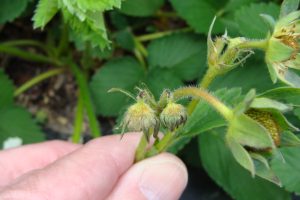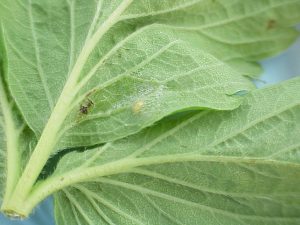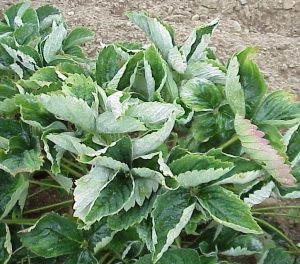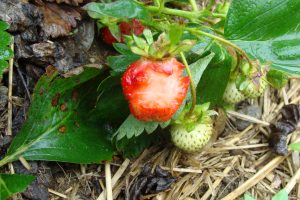Strawberry IPM Newsletter No. 4 – June 2, 2023
SPIDER MITE POPULATIONS HIGHER IN SOME FIELDS
Tarnished Plant Bug and Clippers Still at Very Low Levels
Situation: Insect pests remain at very low levels this week, but high mite populations have become more widespread around the state. Foliar diseases also remain at low levels, but this may change with anticipated wetter weather late this week into next. Overall, the crop is looking pretty good in most fields we are scouting. It looks as though fields may be opening a little earlier, as warm weather for much of the spring has pushed development ahead of normal.

Strawberry bud weevil: Although we did find clipper damage over threshold in one location this week, most fields in southern Maine are now beyond the stage when clipper can cause significant damage. Overall, there has been little clipper injury this season. At this point it is likely that only very late blooming varieties such as Valley Sunset and Malwina could still be significantly affected. Clippers will attack raspberry and blackberry flowers buds when strawberry buds are not available. Although these plants can compensate for the injury better than strawberries, growers may consider protecting the flower buds if lots of clipper are present or damage levels are getting high.
Tarnished plant bug: We found some plant bug nymphs in flowering fields this week, but not yet over the control threshold. We have still not observed nymphs in most of the sites visited. However, we recommend that scouting for nymphs continue, as they may appear very quickly, especially if farmers have started mowing the areas surrounding the field. Tarnished plant bugs can still injure fruit beyond the bloom stage.
Two-spotted spider mites: Spider mites were a little more widespread this week and were over the spray threshold of 25% of leaves infested in two southern Maine fields. The warm weather this week will stimulate mite populations, but cooler damper weather next week should slow their growth.

Spittle bugs: The first spittlebugs of the season were found this week. The frothy spittle masses appear on the leaf stems (petioles), just below the leaflets. These typically start showing up around bloom. Although these spittlebugs don’t pose a significant threat to the plants, the frothy spittle they cover themselves with creates an annoyance for pickers. Adult spittlebugs are about ¼ inch long and bright green when they first emerge, but later turn dull yellow or brown. Spittlebugs overwinter as eggs and the nymphs emerge in late May. You should start to scout for spittlebugs during bloom. Randomly inspect five one square foot areas per field every week. Spread the leaves and inspect the leaf bases, leaf stems, and flower stems looking for the white, frothy spittle masses. Spittlebugs tend to be a greater problem in weedy fields. Pesticides currently registered for spittlebug control include Provado®, Danitol® and Brigade®.
Diseases: Most fields are full to late bloom stage, which is within the period for protecting against gray mold. Intermittent rain and cooler conditions next week will increase the opportunity for Botrytis spores to infect strawberry flowers. Continue fungicide coverage for gray mold with two to three sprays of fungicide during bloom to provide good protection against gray mold.
Leaf spot and leaf scorch we continue to see these foliar diseases at low levels this week. At this point in development, fungicides applied to manage gray mold can control leaf spots as well, including Captan®, Cabrio®, Rally® and Pristine®.

Powdery Mildew: Periods of humid weather can often stimulate symptoms of powdery mildew on strawberry plants. The most obvious indication of this fungus disease is the upward curling of the leaves. Purple or reddish blotches, and/or white, powdery growth may be observed on the undersides of the leaves. Mildew infections weaken plants and can reduce yield the following year. Captan®, Topsin-M®, Pristine®, Cabrio®, Quintec® and Procure® are presently registered to control powdery mildew.
Anthracnose fruit rot: Just a reminder that as fruit starts to ripen in some fields, anthracnose fruit rot can become a problem. This fungus disease can spread rapidly via splashing water during rain or irrigation events. Anthracnose causes black sunken lesions on the berries with orange spore masses in them. It is known to appear suddenly and quickly infect much of the field. Recommended fungicides for anthracnose include Pristine®, Cabrio® and Abound®.
Birds, especially cedar waxwings, will soon be moving into fields to feed on ripe fruit. Where wax wings are a problem, only keeping a near constant presence in the field and eliminating roosting sites can reduce the damage. Avian Control®, a chemical repellent containing methyl anthranilate is registered for use on strawberries. Some growers have found this to be helpful, others have seen little effect. It is important to use the higher rate on strawberries and begin applications before the birds are regularly feeding in the field.
Bird Damage Prevention for Northern New England Fruit Growers is a free online publication by retired University of New Hampshire Extension Specialist Alan Eaton.

Songbirds, including cedar waxwings, are protected by law and should not be killed. However, permits may be issued for killing birds by the U.S. Fish and Wildlife Service if they receive a recommendation for such a permit from the Maine Wildlife Services Office (part of the USDA Animal and Plant Health Inspection Service) in Augusta, along with an application from the grower. There is a $50 fee for the application, and it may take over a month for the permit to be processed. However, the permit is good for one year, so if you have problems this season, you may consider applying for a permit this winter, which would allow you an option to kill birds, if necessary, next season. The Wildlife Damage Office has recommendations for managing birds in crops, and also has some control options available through their office. For more information on permits or bird control contact the office in Augusta at 207.629.5181. The office is located in the Capital West Business Center at 79 Leighton Road in Augusta.
Spring Growers’ Twilight Meeting
The Maine Vegetable & Small Fruit Growers Association will be having a Spring Twilight Meeting on Tuesday, June 6, at 5:30 pm at Stevenson’s Strawberries, 271 Tucker Road in Wayne. The Stevenson’s specialize in strawberries but also grow a wide variety of vegetables for their stand and CSA.
2022-2023 New England Small Fruit Management Guides is the latest edition of the Guide.
Sincerely,
David T. Handley
Vegetable & Small Fruit Specialist
Highmoor Farm
P.O. Box 179
Monmouth, ME 04259
207.933.2100
Pest Management Unit
17 Godfrey Dr.
Orono, ME 04473
1.800.287.0279
Where brand names or company names are used, it is for the reader’s information. No endorsement is implied nor is any discrimination intended against products with similar ingredients. Always consult product labels for rates, application instructions and safety precautions. Users of these producers assume all associated risks.
The University of Maine is an equal opportunity/affirmative action institution.
